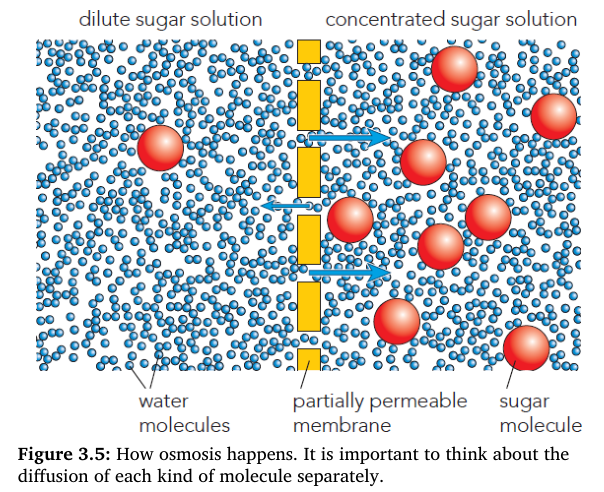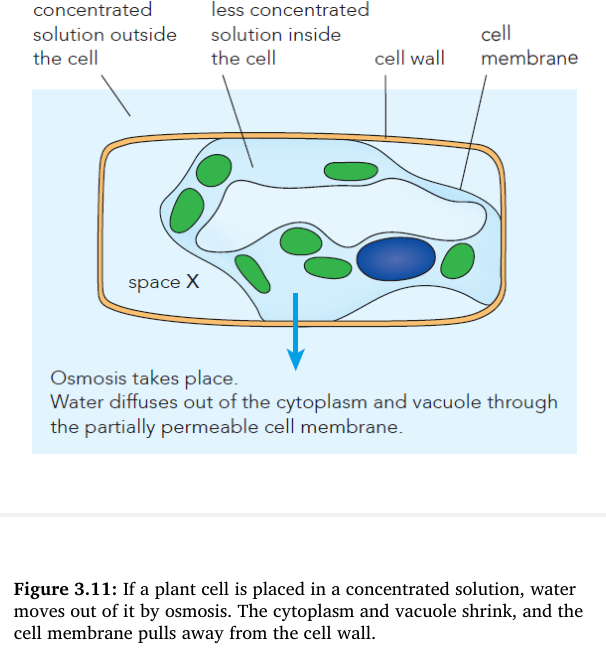Look at the definition of diffusion in the Key words box. Explain
what each of these words in the definition means:
a. net
movement
b. concentration gradient
c. random movement
a. net movement – the overall result of some
particles moving one way, but more
moving in the other
direction
b. concentration gradient – a
difference in concentration between two solutions;
the gradient
‘slopes down’ from the high concentration to the lower
concentration
c. random movement – movement in
any direction, just by chance
When substances diffuse into and out of cells, which part of the cell must they move through?
cell membrane
Describe three examples of diffusion in organisms. For each example, state whether the substance that is diffusing is a gas or a solute.
Any three from (or other correct examples):
- oxygen gas diffusing from outside a cell to inside
- carbon dioxide gas diffusing from inside a cell to outside
- oxygen gas diffusing from inside a photosynthesising cell to outside
- carbon dioxide gas diffusing from outside a photosynthesising cell to inside
- glucose or other solutes diffusing through the cytoplasm of a cell.
Where does the energy for diffusion come from?
the kinetic energy of the particles
Using what you know about how diffusion happens, explain each
of
these statements:
a. Diffusion happens faster at higher
temperatures.
b. The greater the difference in concentration
between two solutions, the faster diffusion happens.
c. In a
kidney dialysis machine, many small tubes containing dialysis fluid
are used, rather than one big one.
d. In a kidney dialysis
machine, the membrane separating the blood and the dialysis fluid is
very thin.
a. At higher temperatures, particles have more kinetic energy and move faster.
b. The greater the diffusion gradient, the faster the rate of diffusion. (Some learners may be able to explain this in terms of the larger number of moving particles in the area of high concentration, resulting in a greater net movement towards the area of low concentration.)
c. Many small tubes have a larger surface area than a single large tube, which speeds up diffusion.
d. This decreases the distance across which the particles have to travel, to get from the blood into the dialysis fluid, so it takes them less time.

These questions are about the diagram in Figure 3.5.
What is the solvent in the sugar solution? What is the solute?
Water is the solvent, and sugar is the solute.

These questions are about the diagram in Figure 3.5.
Explain why water molecules can move from one side of the membrane to the other, but sugar molecules cannot.
The water molecules are small enough to get through the holes in the membrane, but the sugar molecules are too big.

These questions are about the diagram in Figure 3.5.
In which direction is the net movement of water molecules?
From the dilute solution to the concentrated solution.

These questions are about the diagram in Figure 3.5.
Where does the energy come from, to cause this movement of water molecules?
The kinetic energy of the water molecules.

In Figure 3.5, which solution has the higher water potential? Explain your answer.
The dilute solution has the higher water potential, because it
contains more water
molecules.
Copy and complete this sentence:
When an animal cell is placed in pure water, water ____________________ the cell by ____________________ through the partially permeable cell ____________________.
When an animal cell is placed in pure water, water enters the cell by osmosis through the partially permeable cell membrane.
Animal cells burst if they are placed in pure water, but plant cells do not. Explain why.
Plant cells have a strong cell wall surrounding the cell membrane, which stops the cell bursting.
Here are some descriptions of what happens to a plant cell when it is placed in a concentrated solution. They are in the wrong order. Write the descriptions in the correct order.
- The cytoplasm and vacuole shrink.
- The cell membrane is pulled away from the cell wall.
- Water moves out of the cell through the partially permeable cell membrane.
- Water moves out of the cell through the partially permeable cell membrane.
- The cytoplasm and vacuole shrink.
- The cell membrane is pulled away from the cell wall.

Look at Figure 3.11. What fills space X? Explain your answer.
The same solution that the cell is immersed in. The only thing between the external solution and space X is the cell wall, which is fully permeable.
A group of plant cells has been placed in a concentrated solution, and the cells are plasmolysed. Predict what will happen if the cells are now placed in pure water. Explain your answer, using the term water potential.
- The cells will take up water by osmosis, because the water
potential of the water
outside the cell is greater than the water potential of the solution inside the cell. - The vacuole and cytoplasm will increase in volume, so the cell membrane will be pushed back against the cell wall, into its normal position.